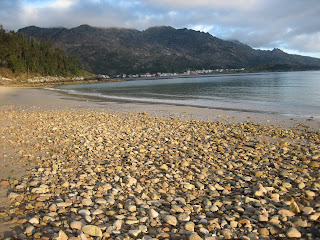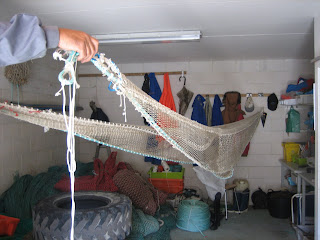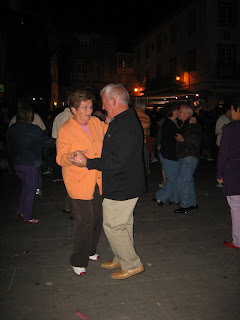2) Site of a water trickle – but it becomes the site of a waterfall when the dam is opened.
3) The “off-limits” machinery room in the electrical building at the base of the river. Some of the equipment is over a hundred years old. I was leaving the museum when the man who had first showed me how to get to it said, “Pssst. Come here. I’ll show you something cool.” (It didn’t sound nearly as sketchy then as it does now in writing.) And he gave me a tour of this room! (And it was not sketchy, because clearly he meant “cool” in the geeky sense of the word.)
4) This is Ezaro on a blue-sky day.
5) If I were a beach, my sand would always have neato-looking patterns like these.
6) And a section of large pebbles. This makes me think of Giant Land in Mario Brothers 3, which I played far too much when I was a little kiddie (as evidenced by the fact that these rocks make me think of it).
7) The waterfall!
8) This is the beginning of the path up to the top of Monte Pindo, A Moa. You begin to understand why one of my flip flops broke on the way down.
9) See the fog?! Magical.
10) Dead trees.
11) Ah, tres belle, tres belle.
12) The view from the top of the mountain! Do you see the very little hill at the end of the coastline? I was there! That’s Monte Louro. Also – FACTOID – this beach, Praia da Carnota, is the longest in Galicia.
13) Wind turbines! And Ezaro from high above.
14) The river just below the dam.
15) My hiking companions, post-hike and pre-swim. From left to right, they are: Manel, ____, Zoraya, Pilar, and Dogs Behind The Tree (they have names, but I have forgotten them).
16) This is a port near the town of Quilmas, which is south of O Pindo (which, in turn, is south of Ezaro). The buildings, which I originally thought were houses, are used to store fishing equipment, like nets and cages.
17) The walk along the equipment storage buildings.
18) A boat! A building! A blue-sky! A beauty-place!
19) Ruins. This was supposed to be an artsy-fartsy picture, but it just turned out a bit confusing (maybe fartsy, but not so artsy).
20) Again. Don’t judge me too harshly, fine photographers. I do appreciate the aesthetic appeal of the scene, even if I can’t capture it.
21) A walk to the coast through these bushes is a cure for the common bad mood (also makes you look tough – scratches all over your legs. Now when people look at me the first thing they think is: “TOUGH”).
22) Here you can see part of the structure of the dam – water flows through those pipes. The blue water is river water, not ocean, and you can see some of the boats that rest in this little harbor.


















































